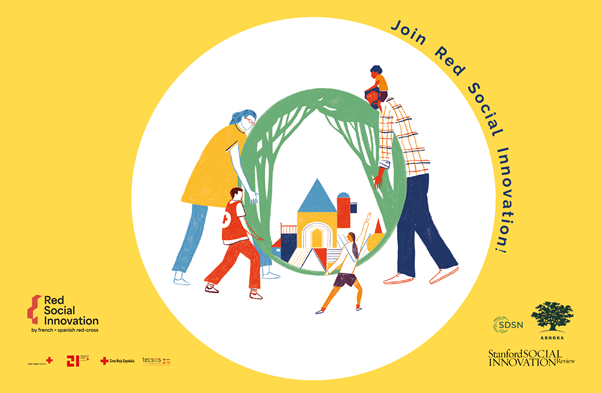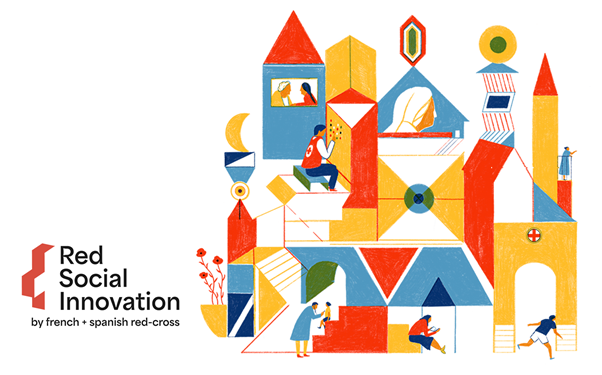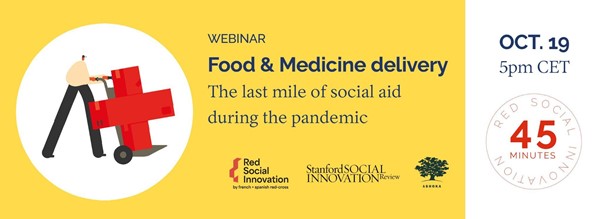Red Social Innovation
With the COVID-19 pandemic exacerbating existing socio-economic inequalities, innovative solutions to facilitate social inclusion have become ever more pressing. As health and climate crises continue to disrupt our social fabric and accentuate inequalities throughout the world, the French Red Cross and the Spanish Red Cross have launched Red Social Innovation, a digital platform to share and learn about transformative social and technological innovations to help people cope with the socio-economic challenges of tomorrow.
The upcoming publication of the European Union (EU) Action Plan on Social Economy on 8 December will mark an important milestone in advancing collective interests and social and environmental objectives at European level. In this context, the role played by non-profit actors cannot be under-emphasised. Red Social Innovation gathers a range of case studies of the social impact that National Red Cross Societies in the EU and beyond have by implementing solutions to help the most vulnerable in their domestic operations.

The platform also facilitates the exchange of best practices within the International Red Cross and Red Crescent Movement (the Movement) and with other actors to drive efficiency and save resources. We caught up with Giulio Zucchini, Chief of International Innovation of the French Red Cross, and Ana Peñalver Blanco, Project Manager at the TECSOS Spanish Red Cross and Spanish Vodafone Foundation, who shared their insights and experiences working on Red Social Innovation.
Could you explain briefly what Red Social Innovation is?
“Red Social Innovation is an international resource centre for social innovation, with the goal to test, scale and highlight social innovations created and developed within the Movement, or by other private and public actors. Through weekly articles and stories available in English, French, and Spanish, it sheds light on tested and approved social innovations from across the world and supports the sharing of good practices”, shares Giulio.
Why did you create the platform?
“We saw a need to promote sharing of practices among National Red Cross and Red Crescent Societies and to create a tool for social actors to get inspired and find solutions to address their domestic needs using methods that have already been tried and tested elsewhere. Red Social Innovation is meant to be the flagship platform for the components of the Movement to learn from each other and improve outcomes for the most vulnerable people and communities”, says Ana.
“Indeed, our ultimate aim is to bring in solutions from all over the globe – not only National Societies from larger or richer countries implement innovations! One out-of-the-box example is Sifi – an initiative launched by the Ecuadorian Red Cross allowing young people, both employees and volunteers to develop a product or service supported by the methodologies of social entrepreneurship. This programme is very inspiring as it shows different and new forms of engagement. Innovation does not necessarily need to be digital, as long as it is a novel, creative way to meet new and existing needs”, Giulio adds.
How do you select the projects that ultimately make it onto your platform?
“We have four selection criteria”, explains Ana. “The solution needs to effectively contribute to meeting a social need or an organisational challenge faced. It also has to provide a new response. Moreover, the solution must have obtained conclusive results in its first pilot, and finally, it should improve the impact or functioning of the organisation. With every piece we publish, we include an info-box about the project with a detailed description of how the solution presented meets all of these criteria”.

Can you share an example of the importance of exchanging best practices and learning from each other through the platform?
“For example, the “Croix-Rouge chez vous” programme originated during the early stages of the COVID-19 outbreak in France. Mobile volunteer teams deliver food and medicine to people who have to isolate as a measure to contain the spread of the virus. The programme has its origins in practices by the Italian Red Cross, which carried out such deliveries when COVID-19 began to spread rapidly in Italy, as one of the first affected countries in Europe. “Croix-Rouge chez vous” demonstrates that individual National Societies and other social organisations can capitalise on each other´s initiatives, and Red Social Innovation offers a platform for the whole Movement to come together, get inspired, exchange good practices, and make a change to their respective social systems”, says Giulio.
What, in your opinion, drives Red Cross Red Crescent staff and volunteers to find innovative solutions like the ones showcased on Red Social Innovation?
“Red Cross and Red Crescent volunteers and staff are on the frontline of social needs on the ground”, Ana points out. “They know the difficulties, and the human and logistical challenges of the mission they fulfil every day. Our duty is to support them with methodologies and inspiring innovative solutions that capitalise on the work of other National Societies or organisations”.
How does your platform interact with external actors and stakeholders in the social economy?
“As a part of the International Red Cross Red Crescent Movement, we are aware of the strengths of our organisation. At the same time, we have to be humble and curious about what other organisations, social start-ups and private actors are building. Social challenges will increase, and we are convinced that we have to work more closely with other actors through a co-creation approach”, says Giulio.
“Red Social Innovation is an open tool to every organisation, citizen, and entrepreneur providing solutions to face the social challenges of today and tomorrow”, Ana adds.
What is needed to promote social innovation through public policies, such as the upcoming Action Plan on Social Economy?
“Covid-19 has been a challenge for the whole social and health sector. But it also reminded public institutions of its importance. What is often underestimated by the traditional economy is the weight of the Social Economy: it counts 2,8 million organisations and enterprises and 13.6 million employees, representing 8% of the EU´s GDP”, Ana stresses.
“Today, the Social Economy must be recognised, valued, and supported because it represents the pillar of social, medico-social and health support, but is also capable of integrating the private sector in a more inclusive and social approach. Thus, the Social Economy has a fundamental place in the world of tomorrow: it represents the vector that will be able to change the role and commitment of companies within a sustainable and inclusive society”, Giulio concludes.
Besides the French Red Cross and the Spanish Red Cross, the partners of Red Social Innovation are the International Federation of Red Cross Red Crescent Societies (IFRC), the International Committee of the Red Cross (ICRC), the Movement´s Solferino Academy, Ashoka, the Sustainable Development Solutions Network UNSDSN, and the Stanford Social Innovation Review. Technical support is provided by the TECSOS Foundation – a non-profit foundation created by the Spanish Red Cross and the Vodafone Spain Foundation, as well as by 21, the Social Innovation Accelerator of the French Red Cross.
45 Minutes, the cycle of events about social innovation
In partnership with the Stanford Social Innovation Review and the social entrepreneurs network Ashoka, Red Social Innovation is launching '45 minutes', a series of events to discover impact-proven solutions to the world's most pressing issues. The first event will focus on Food & Medicine Delivery, the last mile of social aid during the pandemic. Register here to join in to learn & share more innovative solutions overcoming the challenges of last-mile delivery.
For media inquiries, please contact Eva Oyón on: eva.oyon@redcross.eu or +32 2 235 09 22


